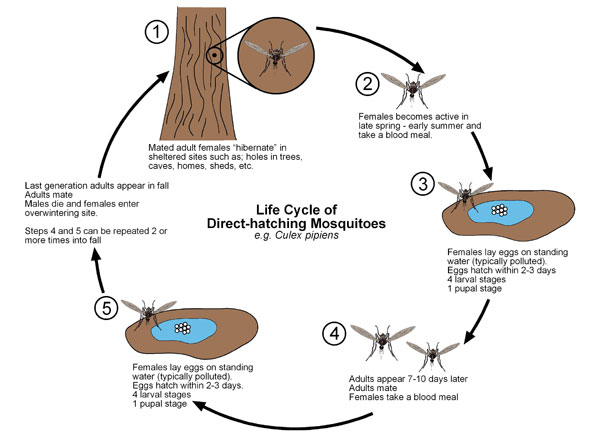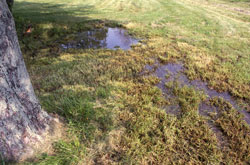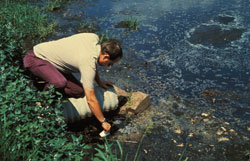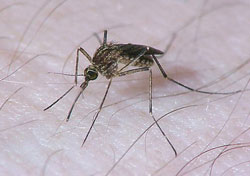
Insects and Ticks > Mosquitoes
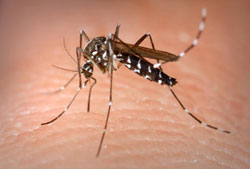
This is an Aedes albopictus female mosquito obtaining a blood meal from a human host. Photo by: James Gathany
Mosquitoes are well known as annoying biting pests and vectors of disease-causing agents to humans and other animals. Numerous information sources discuss mosquito biology, mosquito-borne diseases, methods of personal protection, and approaches to mosquito control. Still, many people lack understanding of the biology and public health importance of mosquitoes. You are encouraged to learn more about the biology of mosquitoes in Indiana. This will enable you to make more informed decisions about health risks and whether to attempt mosquito control.
What is the Public Health Risk of Mosquitoes in Indiana?
Mosquitoes can be very annoying, their bites can produce itchy welts, and the bites of some species are painful to certain individuals. "Quality of life" can be reduced in areas with high numbers of biting mosquitoes. Mosquitoes also are vectors (transmitters) of several viruses that can cause severe disease and even death in humans, including West Nile Virus, St. Louis Encephalitis Virus, LaCrosse Encephalitis Virus, Eastern Equine Encephalitis Virus, and Western Equine Encephalitis Virus.
There are an estimated 3,200 species of mosquitoes in the world, of which about 174 occur in the continental United States.
How Many Types of Mosquitoes Are There in Indiana?
Approximately 55 species have been documented in Indiana, but only about 12-15 species are of significance to public health. These include vector species such as some Culex mosquitoes that transmit West Nile Virus. It also includes nuisance species such as some Aedes, Ochlerotatus, and Psorophora mosquitoes that are aggressive bloodsuckers, but are not known to be vectors of West Nile Virus. Overviews of mosquito genera that include species of greatest public health importance in Indiana are provided below, following sections dealing with aspects of general mosquito biology.
Yes, females of a few Indiana species either do not take blood meals (Toxorhynchites) or do not feed on humans. Surprisingly little is known about the feeding behavior of species of Orthopodomyia, Uranotaenia, and Wyeomyia mosquitoes, but none are considered to be of concern to public health.
Are There Exotic Mosquitoes of Public Health Importance That Have Been Introduced Into Indiana?
Yes, two species from Asia, Aedes albopictus, the Asian tiger mosquito, and Ochlerotatus japonicus are established in certain areas of Indiana. Larvae of both species develop in container habitats, including discarded tires, and females are aggressive biters of humans. Both species are vectors of viruses in other parts of the world and are assumed to be in Indiana. The Indiana State Department of Health is monitoring them.
What is the Life Cycle of Mosquitoes in Indiana?
Mosquitoes develop from egg to adult via a process of complete metamorphosis. This means they have a pupal stage in which the aquatic larva transforms into a flying terrestrial adult. All species of mosquitoes have four life cycle components: an egg stage; four larval stages; a non-feeding pupal stage; and an adult stage.
Mosquito eggs are laid either singly or together in a raft-like structure that floats on water, and they hatch via one of two mechanisms. Awareness of the differences between these two mechanisms is essential to understanding the diversity of mosquito life cycles and to practicing the most effective approaches to mosquito control.
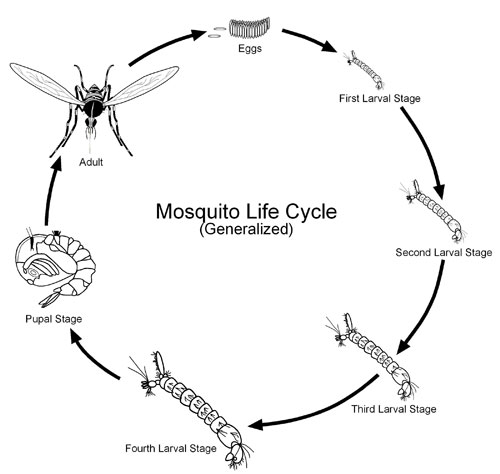
Note: Each larval stage is larger than the previous one. Molting occurs between each larval and pupal stage. Larval and pupal stages are aquatic.
Illustration by: Scott Charlesworth, Purdue University
Direct-hatching eggs are laid on top of shallow standing water and hatch within 2-3 days. Indiana mosquitoes that have direct-hatching eggs include those that are vectors of West Nile Virus, namely species in the genus Culex.
Delayed-hatching eggs are laid on moist substrates in sites where standing water existed previously. These eggs are dormant and must experience a period of dryness before they are capable of hatching. Following a satisfactory dry period of at least several days and perhaps to up to several years, these eggs may hatch after being covered with water. The ability of dormant delayed-hatching eggs to remain viable through dry periods is especially important to understanding the biology and distribution of nuisance mosquitoes associated with flood waters, including Aedes vexans, one of the most common species in Indiana.
Mosquito larvae, or "wrigglers," require water in which to feed and complete development. Nearly all obtain oxygen during visits to the water surface. Mosquito larvae are categorized as filter feeders, grazers, or predators.
- Filter feeders have mouthparts that rotate rapidly to produce water currents from which the mouthparts filter out food particles in suspension.
- Grazers feed by scraping off bacteria and algae growing on aquatic substrates.
- Larvae of several species of mosquitoes are predators that feed on the larvae of other mosquitoes.
The duration of each of the four larval stages is dependent on food supply, density or crowding, and water temperature, but most species complete larval development in a week or so.
Mosquito pupae, or "tumblers," typically require water in which to complete the transformation to the adult stage. Those of a few species can complete the 2-3 day process in mud. Similar to larvae, nearly all mosquito pupae obtain oxygen during visits to the water surface.
An understanding of the method by which mosquito larvae and pupae obtain oxygen helps to explain two important aspects of mosquito biology and control. First, some species of mosquitoes are able to survive in water with low levels of dissolved oxygen, but most mosquito predators, including minnows and aquatic insects, need higher levels of dissolved oxygen to survive. In the absence of natural enemies, mosquito larvae are able to thrive and often exist in very high densities, eventually leading to large numbers of biting females. Second, mosquito larvae and pupae are vulnerable to mosquito control compounds, see Extension Entomology publication E-52-W "Mosquito Management by Trained Personnel" (PDF 283KB), that cover the water surface and prevent them from acquiring oxygen. These surface films do not affect natural enemies of mosquitoes that utilize dissolved oxygen, and thus such compounds are valuable in controlling mosquito larvae and pupae while conserving predators.
Adult mosquitoes emerge from pupal cases at the water surface. Males typically emerge 2-3 days before females from the same group of eggs. Males feed on a sugar source, not blood, mate, perhaps with multiple females, and usually die within several days. Females feed on a sugar source, mate, feed on blood, and eventually lay eggs. The process of blood feeding and egg laying may be repeated several times by a single female in her lifetime. Females live a few weeks to several months, depending on the species.
How Do Mosquitoes Survive Winter?
The vast majority of Indiana mosquitoes over-winter in a state of dormancy either as delayed-hatching eggs laid in sites subject to inundation the following spring and summer (adult females do not over-winter) or as mated females that have emerged from direct-hatching eggs. Over-wintering females shelter in sites such as caves, culverts, and human dwellings. An extended period of cold (equivalent to the passage of winter) is required before delayed-hatching eggs that have gone through a period of being dry are capable of hatching. An extended period of cold also is required before over-wintering females are capable of developing eggs.
Where Do Mosquito Larvae Develop?
Generally, mosquito larvae require bodies of water that are non-flowing and relatively shallow, and that often support grassy vegetation or some form of surface cover such as algal or fecal mats. The major types of larval habitats include:
- Permanent and semi-permanent bodies of water (e.g., sites at which shallow water stands for at least a week or two, usually longer).
- Transitory or alternating wet and dry sites (e.g., stream overflows, flooded ground pools, and irrigated pasture).
- Containers (including natural containers such as tree holes and rock pools plus wheel ruts, rain gutters, street drain basins, and discarded items such as tires and cans).
See E-240-W "West Nile Virus in Indiana" (PDF 920KB) for additional images of sites that are typically associated with mosquitoes.
The most important nuisance species and vector species in Indiana exploit and thrive in aquatic habitats that either are free of natural enemies (i.e., polluted) or in which larval development is completed before natural enemy populations become established (i.e., transient ground pools and artificial containers).
Marshes, bogs, restored wetlands, and well-maintained ornamental ponds are not significant producers of nuisance and vector mosquitoes. Such habitats typically are not polluted, contain enough dissolved oxygen to support an established complex of natural enemies of mosquito larvae, including fish, and usually are marked by the growth of cattails and the existence of duckweed on the water surface.

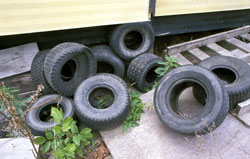 Improperly maintained gutters and old tires left on properties are habitats for nuisance and vector species.
Improperly maintained gutters and old tires left on properties are habitats for nuisance and vector species.Photos by: Purdue University
How Do Humans Influence Larval Development?
Larvae of most nuisance and vector species develop in habitats directly or indirectly associated with human activities, including polluting water, discarding containers, improperly maintaining gutters, ineffectively managing flood and irrigation water, and building catch basins that alternate between being wet and dry. In many cases, exposure to nuisance or vector mosquitoes can be significantly reduced or prevented without the use of pesticides by eliminating or preventing these conditions. The main exception is the naturally existing areas along streams in which floodwaters collect. When flooded, these areas become suitable sites for the hatching of eggs of Aedes, Ochlerotatus, and Psorophora mosquitoes and can produce huge numbers of nuisance biting adults.
Where Do Mosquitoes Mate?
The act of mating has been documented for surprisingly few species of mosquitoes, but among those studied diversity exists in regard to when, where, and how they mate.
"Swarming" is a phenomenon associated with mating in many species of mosquitoes. It involves males congregating and performing species-specific "dances" in the air above "swarm markers." These are sites to which males are attracted, including large rocks, tree stumps, or the preferred host from which females take a blood meal. A "swarm" typically includes males of one species that gather at dusk or during warm mornings. Females locate and fly into the swarm. Males of several species are known to respond to the wing beat frequency of females of the same species that fly into the swarm. The final stimulus for mating is species-specific chemicals on the body of females that are sensed by a male when he makes contact with a female.
What Do Adult Mosquitoes Feed On?
Nectar, plant sap, and honeydew produced by insects such as aphids provide the main energy sources for adults. These sugar sources provide the only food for males, who do not take a blood meal, and for the females of species that do not feed on blood. Egg production in females of all other species is dependent on a blood meal, with the following exception. Females of certain species are capable of developing one egg mass before taking a blood meal. This is a process known as "autogeny," and egg production is supported using energy reserves obtained during larval feeding.
Females of most mosquito species are attracted to warm-blooded animals. The most common hosts include birds and mammals, but females of several species take blood from reptiles and a few others from frogs. Females of most species of mosquitoes tend to restrict feeding to a particular period of the daily cycle, typically periods of low light intensity. Blood feeding is most common at twilight into early evening, but also can occur during warm mornings and on cloudy days.
Female mosquitoes detect carbon dioxide emitted from warm-blooded animals over long distances. As a female flies upwind to a host, other cues play a role, including vision, moist air currents arising from a host, and specific odors emitted by a host. Mosquito repellents appear to act by masking the odor cues or by direct repellency to approaching females. Repellent products containing low concentrations (approx. 20-30%) of diethytoluamide (DEET) are known to be effective. The Centers for Disease Control and Prevention recently recommended products containing picaridin and lemon of eucalyptus as alternatives to DEET. Various other compounds such as citronella, garlic, and vitamin B are purported to be effective repellents, but research does not support this.
How Far Do Females Travel to Feed and Lay Eggs?
Female Culex mosquitoes are noted for very short flight ranges. They feed and lay eggs within close proximity, usually within a quarter mile or so of the water in which they completed larval development. For this reason, it is important to eliminate or treat developmental sites in and around areas in which West Nile Virus and other viruses transmitted by Culex mosquitoes have been detected in birds and humans. On the other hand, females of certain Aedes, Ochlerotatus, and Psorophora species are capable of long flights, often as far as 5-15 miles. These mosquitoes are noted for biting people many miles down-wind from the aquatic habitats in which the larvae developed.
What Mosquitoes are of Greatest Public Health Importance as Nuisance Biters and Vectors?
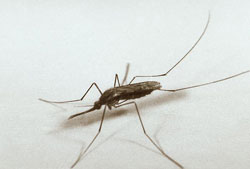 This is a photograph of an Anopheles quadrimaculatus mosquito.
This is a photograph of an Anopheles quadrimaculatus mosquito. Photo by: Edward McCellan, Center for Disease Control and Prevention
Anopheles: Species in the genus Anopheles are known as malarial mosquitoes because they are involved in the development and transmission of the protozoan parasites that cause human malaria. There are about 20 species of Anopheles in the continental United States, six of which occur in Indiana. These include the common An. punctipennis and the less common An. quadrimaculatus, a species that can be locally abundant in habitats where organic pollution is minimal. In addition to malaria, certain species of Anopheles are known to transmit dog heartworm, but none are thought to be important vectors of West Nile Virus.
Anopheles females feed primarily on large mammals and a few species feed readily on humans. Females deposit single, direct-hatching eggs onto the surface of standing water. Examples of the permanent or semi-permanent larval habitats include forest floor pools and algae-covered water associated with agricultural land, roadside ditches, and poorly maintained water troughs. In Indiana, Anopheles species may undergo two or more generations a year. All species over-winter as mated females, which become active the following spring and are among the first mosquitoes to bite humans each year.
Yes, Anopheles quadrimaculatus was the primary vector of malaria in the eastern U.S., including Indiana, into the 1930's when the last major outbreaks occurred. Malaria has been eradicated from the United States since the early 1940's. This was due to a combination of mosquito control, improved medical care, a higher standard of living, and the transformation of Anopheles larval habitat into agricultural land.
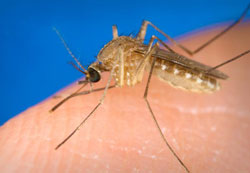 Known as a vector for the West Nile virus, this Culex mosquito has landed on a human finger.
Known as a vector for the West Nile virus, this Culex mosquito has landed on a human finger. Photo by: James Gathany, Center for Disease Control and Prevention
Culex: Species of Culex include a complex known as "house mosquitoes" and, more recently, "West Nile mosquitoes" because of their involvement in the transmission of West Nile Virus. There are about 28 species of Culex in the continental United States. Seven species occur in Indiana, of which four are involved in the transmission of West Nile Virus among birds and potentially to humans and horses. In addition to West Nile Virus, certain species of Culex are known to transmit St. Louis Encephalitis Virus and Western Equine Encephalitis Virus.
Females of most Culex species feed primarily or to a great extent on birds, potentially exposing them to viruses maintained in bird populations. For example, Cu. restuans is a very common, early season species that feeds almost exclusively on birds. This species is thought to be the main vector that increases West Nile Virus levels in bird populations. Culex pipiens is a very common, mid- to late-summer species that feeds primarily on birds, but also feeds on mammals. This species also may be a vector of West Nile Virus to humans and horses. Culex salinarius is a common mid- to late-summer species that feeds readily both on birds and mammals. This species is considered the most important "bridge vector," acquiring West Nile Virus from birds and transmitting it to humans and horses.
Culex females deposit egg rafts onto the surface of standing water. Egg rafts, consisting of 200-300 direct-hatching eggs glued together, float on the surface and appear as small, black, boat-shaped objects. Culex larvae often are found in the same habitats mentioned above for Anopheles, but they occur in a much broader range of sites. For example, Cu. pipiens larvae are capable of developing in heavily polluted water such as in wastewater evaporation ponds and in accumulations of effluent from malfunctioning septic systems, and Cu. restuans larvae are very common in water containing decaying vegetation such as fallen leaves and grass clippings. The latter sites include deep wheel ruts and drainage channels that have stopped flowing and in which standing water exists. Culex larvae also are noted for developing in container habitats that contain foul smelling water, including discarded tires, water barrels, flower pots, and clogged gutters. During extended periods of drought, in the absence of flowing water, street drain basins and contaminated ponded streams become productive larval habitats.
Culex species may undergo two or more generations a year. All species over-winter as mated females that, depending on species, become active the following late spring to mid-summer. For example, Cu. restuans females are among the earliest mosquitoes to begin reproducing, with larvae found in mid-April, while larvae of Cu. pipiens and Cu. salinarius usually are not found until mid-summer.
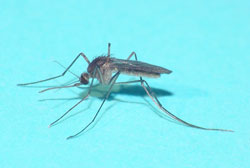 Culiseta tend to be dark mosquito that are not often collected in traps and generally do not bite humans. This particular species occurs in southwest Western Australia.
Culiseta tend to be dark mosquito that are not often collected in traps and generally do not bite humans. This particular species occurs in southwest Western Australia.Photo by: Institute of Clinical Pathology and Medical Research
Culiseta: Most of the public has little or no awareness of Culiseta mosquitoes, and common names do not exist even for the most important species. There are eight species of Culiseta in the continental United States, of which four occur in Indiana. Two species, Cs. melanura and Cs. morsitans, are known to be involved as a vector of Eastern Equine Encephalitis Virus among birds in northern Indiana. Females of Cs. inornata feed on mammals, with a preference for large hosts such as livestock and humans.
Females of Indiana species deposit egg rafts on standing water and the eggs are direct-hatching. Larvae of Cs. inornata develop in permanent water habitats, including shallow marshes, peat bogs, roadside ditches, abandoned gravel pits, and in standing water in soil cavities left by fallen trees. Larvae of Cs. melanura develop in water contained in ground-level tree holes that are associated with wood, soil, and darkness; they over-winter in mud in the bottom of such sites. Mated females of Cs. inornata over-winter and are among the earliest mosquitoes to appear the following April.
 This a female Aedes aegypti mosquito.
This a female Aedes aegypti mosquito.Photo by: James Gathany, Center for Disease Control and Prevention
Aedes and Ochlerotatus: Certain species are widespread, occur in very large numbers at times, and are among the worst biting pests. Numerous species have been given common names, including the rainwater and floodwater mosquitoes, the snowmelt mosquitoes, the salt marsh mosquitoes, the tree hole mosquitoes, and the Asian tiger mosquito. Females of some species are drab, others have white-striped legs, and some possess both striped legs and prominent silvery scales on their bodies.
There are about 80 species of Aedes and Ochlerotatus in the continental United States, of which at least 22 occur in Indiana. In addition to being major biting pests, numerous species are vectors. Fortunately, the two most abundant floodwater species in Indiana, Oc. trivittatus and Ae. vexans, do not appear to be vectors of West Nile Virus. Several species are known to be vectors of dog heartworm, the most important in Indiana being Oc. trivittatus. Females of most species feed on mammals, including chipmunks and squirrels, in addition to deer, livestock, and humans. Birds also serve as sources of blood meals.
Aedes and Ochlerotatus females lay single, delayed-hatching eggs on moist substrates such as soil and the sides of containers around the high water level. Developmental sites of larvae vary greatly. The most productive include transient ground pools, flooded areas along overflowing streams, rainwater catch basins, and container habitats such as tree holes, wheel ruts, and discarded tires.
Some species of Ochlerotatus known as the "snow pool" complex undergo only a single generation per year. Most Aedes and Ochlerotatus complete two to several generations depending on the frequency and amount of rainfall events. All species in Indiana over-winter as eggs.
The taxonomy of mosquitoes is under study and currently in review, including the largest group known as "Aedes" mosquitoes. Some scientists recently elevated to genus level a large number of species in the subgenus Ochlerotatus of the genus Aedes. This action resulted in nearly all Indiana species being classified in the genus Ochlerotatus and left very few species in the genus Aedes. The justification for this change and the arguments against it are beyond the scope of this publication. For convenience and continuity, we retain the prior, traditional taxonomy and treat all species as being in the genus Aedes.
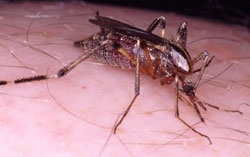 Psorophora ciliata, is found only during wet summers when other mosquitoes are abundant. Their larvae are carnivorous and each one consumes dozens of smaller mosquito larvae.
Psorophora ciliata, is found only during wet summers when other mosquitoes are abundant. Their larvae are carnivorous and each one consumes dozens of smaller mosquito larvae. Photo by: Ojibway Nature Centre
Psorophora: Species of Psorophora mosquitoes are similar to Aedes and Ochlerotatus in many aspects of their biology. Several species are among the most significant biting pests. Common names are lacking with the exception of the "gallinipper", a name given to Indiana's largest bloodsucking mosquito P. ciliata. Female gallinippers are noted for their painful bites, very large size, and prominent "shaggy" legs. Two common, but much smaller species, P. ferox and P. horrida, have bright, white-tipped legs and are noted for their painful bites.
There are 13 species of Psorophora in the continental United States, eight of which occur in Indiana. Psorophora females feed almost exclusively on large mammals and are major pests of livestock and humans, but only one species, P. columbiae, is known to be a vector. Psorophora females lay single, direct-hatching eggs on moist soil. Developmental sites of Psorophora larvae include transient ground pools, extensive flooded areas along overflowing streams, and irrigation water standing in low areas of agricultural land. In contrast to certain species of Aedes and Ochlerotatus, female Psorophora rarely lay eggs in containers. In Indiana, Psorophora species may undergo two or more generations per year. All Psorophora species over-winter as eggs.
Coquillettidia: There is only one species of this genus in Indiana, Cq. perturbans. This species is referred to as Mansonia perturbans in older literature and still today by some authorities. Females, which have a speckled appearance, feed primarily on large mammals. They are aggressive feeders on large mammals and may be involved in the transmission of Eastern Equine Encephalitis Virus to horses and humans in northern Indiana .
Females deposit direct-hatching eggs on the surface of water that supports cattails and other emergent vegetation. Larvae and pupae obtain oxygen from aquatic plants by piercing and attaching to submerged roots and stems. Both stages remain attached to the plants, do not come to the surface, and thus are collected only by using special equipment and techniques. Larvae over-winter attached to roots and stems in subsurface mud.
Why is it Important to Monitor and Identify Indiana Mosquitoes?
Only certain species of mosquitoes are vectors, and monitoring their numbers can provide information regarding the potential for disease activity in the state. Considering only West Nile Virus, the important vectors in Indiana include most species of Culex mosquitoes, but not the common floodwater mosquitoes Oc. trivittatus and Ae. vexans. Females of these two species often exist in extremely high numbers, but their presence is not an indicator of West Nile activity, and controlling them does not reduce virus transmission. In contrast, females of Cu. restuans rarely feed on humans, but this species is an important vector that increases the amount of West Nile Virus among birds. Monitoring Cu. restuans numbers and testing for West Nile Virus in captured females provides information about the potential for transmission to humans later in the season by Cu. pipiens and Cu. salinarius. Females of these two species feed on both birds and mammals and are considered "bridge vectors" of West Nile Virus. Monitoring their numbers and testing for West Nile Virus provides information about existing or impending transmission of virus. Clearly, efforts to reduce transmission of West Nile Virus among birds and potentially to humans should focus on the control of Culex mosquitoes, with elimination or treatment of larval habitats being the most effective approach.
Where Can I Find More Information on Mosquitoes?
Many Web sites provide additional information on mosquito biology and control. The following Web sites are recommended as accurate and current sources of information.
- Purdue Extension Entomology
- Purdue Extension Publication "Management of Ponds, Wetlands, and Other Water Reservoirs to Minimize Mosquitoes"
- Centers for Disease Control and Prevention
- American Mosquito Control Association
- Indiana State Department of Health
Numerous books and other written publications are devoted to mosquitoes. The following texts provide additional information on the biology of mosquitoes in Indiana for the interested reader.
For information on Indiana mosquito species:
- Siverly, R.E. 1972." Mosquitoes of Indiana," Indiana State Board of Health. Indianapolis, IN.
For information on mosquito nomenclature and identification:
- Darsie, R.F. Jr. and R.A. Ward (2005). "Identification and Geographical Distribution of the Mosquitoes of North America, North of Mexico." University Press of Florida, Gainesville.
